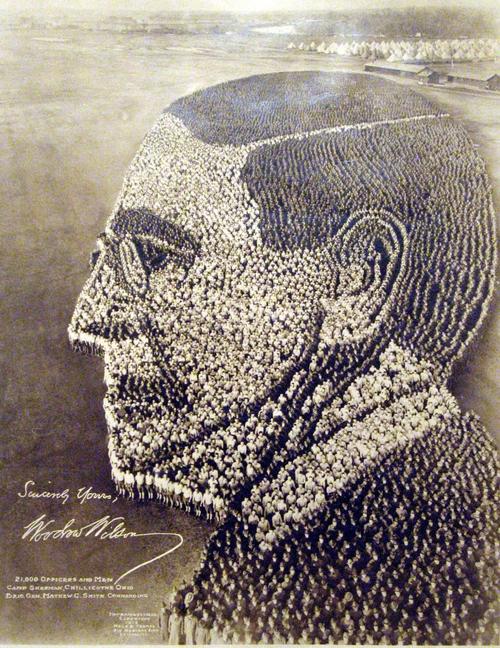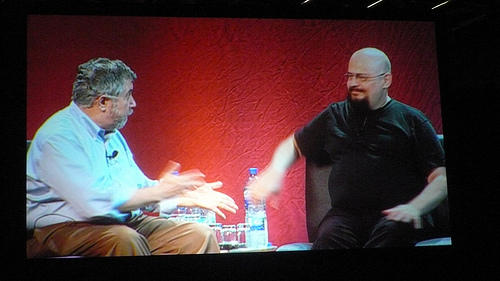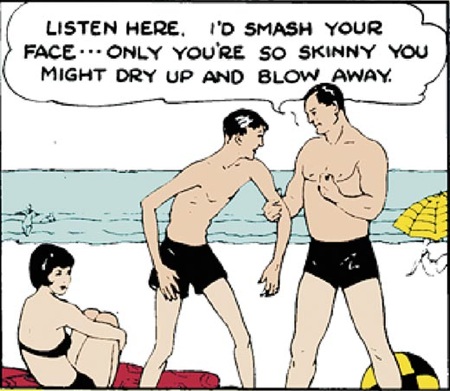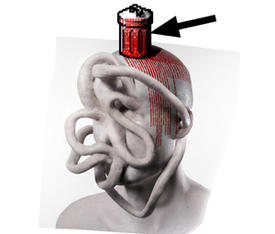The Latest from Boing Boing |  |
- Soldiers as patriotic pixelboards
- Musical kettle that whistles your favorite tune
- Bruce Sterling's story on the merger of blogging and scientific discovery
- Fanciful trompe l'oeil garage-door murals
- Star Wars trash compactor bookends
- Charlie Stross and Paul Krguman talk science fiction and economics at the WorldCon
- Aung San Suu Kyi found guilty by Burma court, will return to house arrest
- Adventures in ill-advised graphic design: Singapore anti- sex trafficking poster
- Twitpocalypse: Best analysis yet of ongoing massive DDOS attacks
- Midcentury Mexican sci-fi kitsch movies: an appreciation
- Flooded Louisville Free Public Library needs your help
- Road-trip guided by coin-tosses and D4 rolls
- You're weird in at least ten ways
- Woman books entire jetliner biz-class so her dog can fly with her
- Next-gen implanted hearing aids are also headphones
- Hugo Award winners and statsporn!
- Are red-headed people more sensitive to pain?
- Army judge: Torture couldn't possibly have caused accused 9/11 conspirator's psychological distress
- Imaginary Foundation's All-Star Pattern Seekers Trading Cards
- Photos of my fifth handbuilt guitar
- In America, it is increasingly illegal to be poor.
- Kidtropolis fantasy kids rooms
- UK road map circa 1675
- Great Caesar's Ghost: Dery on Rome's Cemetery of the Capuchins
- How to speed read
- Tubby Hayes's Voodoo Session
- Holiday Inn signs - now and then
- NY police use trick to arrest people for pot possession
- Unexplained space phenomena captured in photo of Saturn's rings
- Charles Atlas profiled
| Soldiers as patriotic pixelboards Posted: 11 Aug 2009 05:12 AM PDT  Here's a small gallery of Arthur S. Mole and John D. Thomas's photos of thousands of soldiers creating giant, patriotic pixelart images of patriotic scenes. Incredible Pictures Formed by Thousands of US Soldiers (Thanks, Bill!) |
| Musical kettle that whistles your favorite tune Posted: 11 Aug 2009 05:08 AM PDT  Naoki Kawamoto's Musical Kettle is part of a series of inventions that 're-design soundscape' -- it plays your favorite tune when it boils. Musical Kettle 2008 (via Cribcandy) |
| Bruce Sterling's story on the merger of blogging and scientific discovery Posted: 11 Aug 2009 05:04 AM PDT Bruce Sterling has a short-short story in this month's Discover, "In the Future, Doing Science Is Like Blogging." It's part of an Ellen Datlow-edited series on fictionalized future discoveries. I've written one for a forthcoming ish in which a neuro shortcut to creating empathy for fictional people is created and abused by advertisers, destroying all forms of narrative fiction (I originally pitched one about a world in which the cure for obesity turns out to be a turd-transplant from people with "skinny" intestinal flora, but nevertheless the formerly fat are still shunned by the naturally thin; but "eat shit and live" was too gross for the series). In the Future, Doing Science Is Like Blogging |
| Fanciful trompe l'oeil garage-door murals Posted: 11 Aug 2009 04:57 AM PDT   Here's giant, trompe l'oeil garage-door murals that come screened on correctly-sized tarpaulins, ready to be glued to your doors. There's spaceships, vintage cars, escalators to hell, horsebarns, swinging doors, etc. |
| Star Wars trash compactor bookends Posted: 11 Aug 2009 04:52 AM PDT  Love these Star Wars trash compactor bookends, though, as Alice at Wonderland points out, that is emphatically not Luke's nose (either pre- or post-surgery). |
| Charlie Stross and Paul Krguman talk science fiction and economics at the WorldCon Posted: 11 Aug 2009 04:42 AM PDT  One of the highlights of this year's World Science Fiction Convention in Montreal was sf writer Charlie Stross chatting with sf fan and Nobel economics laureate Paul Krugman. Charlie's work touches on many economic themes, and Krugman's reputation for finding economic lessons in everyday life is well deserved; the combination was dynamite. Krugman: Let me show my age here. What you came out believing if you went to the New York's World Fair in 1964 was that we were going to have this enormously enhanced mastery of the physical universe. That we were going to have undersea cities and supersonic transports everywhere. And there hasn't been that kind of dramatic change. It's not just that airplanes are no faster. My favorite test, which shows something about me, is the kitchen. If you walked into a kitchen from the 1950's it would look a little pokey, but you'd know what to do. It wouldn't be that difficult. If someone from the 1950's walked into a kitchen from 1909 they'd be pretty unhappy - they might just be able to manage. If someone from 1909 went to one from 1859, you would actually be hopeless. The big change was really between 1840 and the 1920's, in terms of what the physical nature of modern life is like. There's been nothing like that since. So we can do fancy information searches in a way that no one envisioned 30 years ago - as one of my colleagues at the Times, Gail Collins, likes to say all the time where are the flying cars?A fireside chat Previously:
|
| Aung San Suu Kyi found guilty by Burma court, will return to house arrest Posted: 11 Aug 2009 12:32 AM PDT  "It is not power that corrupts but fear. Fear of losing power corrupts those who wield it and fear of the scourge of power corrupts those who are subject to it." - Daw Aung San Suu Kyi. "It is not power that corrupts but fear. Fear of losing power corrupts those who wield it and fear of the scourge of power corrupts those who are subject to it." - Daw Aung San Suu Kyi. No surprises here: A court in Myanmar (Burma) has issued a guilty verdict for Nobel laureate and opposition leader Aung San Suu Kyi. She was accused of "violating an internal security law," and will serve an additional 18 months imprisonment under house arrest. She has lived under detention for 14 of the past 20 years. Reuters, CNN. Guardian UK has a timeline of events related to the case. |
| Adventures in ill-advised graphic design: Singapore anti- sex trafficking poster Posted: 10 Aug 2009 08:48 PM PDT  The best intentions appear to have gone horribly, double-entendre-ly wrong in a Singapore public service ad campaign which proposes that citizens use hand lotion as a weapon against child sex trafficking. Larger image here. From Aaron "@sfslim" Muszalski, who had this and this and this to tweet about the matter. His adventurous road-tweets from .sg really have been fantastic. |
| Twitpocalypse: Best analysis yet of ongoing massive DDOS attacks Posted: 10 Aug 2009 07:00 PM PDT  From Dueling Analogs webcomic, click here for large size (via Wayne's Friends List) |
| Midcentury Mexican sci-fi kitsch movies: an appreciation Posted: 10 Aug 2009 06:39 PM PDT Over at the WIRED "Underwired" pop culture blog, Hugh Hart has an extensive post up about cheesy, low-budget Mexican science fiction movies from the '50s and '60s. Above, a scene from Santo vs. the Martians (1967), which features the famous Mexican wrestler defending nuestra planeta against space-aliens. Snip: Vintage Mexican Sci-Fi Beams a Blast From the Past, con Queso (WIRED: Underwired) And if you're in Los Angeles, every Friday in August there are screenings of these films over at the Hammer Museum in Westwood. Looks like an amazing lineup, I hope to catch at least one of them: ¡ AZTEC MUMMIES & MARTIAN INVADERS !: MEXICAN SCI-FI CLASSICS |
| Flooded Louisville Free Public Library needs your help Posted: 10 Aug 2009 05:52 PM PDT Joshua sez, "Steve Lawson and the Library Society of the World are trying to raise money to help the Louisville Free Public Library, which was hit by horrible flash floods last week. Could you help us help the library out?" So a lot of those books we sent them in the spring are now covered in water and sewage. And so are the bookmobiles. And the mechanical equipment for HVAC. And the data center. And $50,000 worth of new computers. The initial estimate is $1 million in damage, but they must just be guessing at this point.Louisville Free Public Library needs your help (Thanks, Joshua!) |
| Road-trip guided by coin-tosses and D4 rolls Posted: 10 Aug 2009 07:54 PM PDT A reader writes, "This weekend, my wife and I traveled on a Random Road trip. It turned out great. We used a four-sided die (d4) when there were more than 2 routes to decide upon and a coin for the others. We didn't have any hard and fast rules when we started, but developed some as we drove deeper into the trip. I recommend it to anyone even if you don't have a d4 handy." Near our starting point is the intersection of 2 highways 23 and 94 with convenient N (1), S (2), E (3), and W (4) options. I proposed that we eliminate the "east" option on our first roll, because I wanted to avoid the morass of highways around Detroit. Mrs. BBspot vetoed this idea and she promptly rolled a 3 (east) for our first direction. At this point we had to turn around and go back home to get our passports, because starting in Michigan there's always the danger that we'd end up in Canada. (see map at end of post for a look at our final route)Random Road Trip Recap |
| You're weird in at least ten ways Posted: 10 Aug 2009 05:19 PM PDT The New Scientist's "Ten things we don't understand about humans" is a head-scratching tour of humanity's inexplicables from laughter to pubic hair: Pubic hair: Scent radiator, warmth provider, or chafe protection? The answer to why humans have clumps of hair in private places is still open for debate...Ten things we don't understand about humans (via Kottke) |
| Woman books entire jetliner biz-class so her dog can fly with her Posted: 10 Aug 2009 05:09 PM PDT An Israeli woman spent $38,000 to book the entire business-class cabin of an El Al jet from Paris to Tel Aviv so that her beloved dog could fly with her and be spared the trauma of the cargo hold. Woman flies business class with pooch (Thanks, Tamar!) |
| Next-gen implanted hearing aids are also headphones Posted: 10 Aug 2009 05:14 PM PDT A new generation of bone-conduction hearing aids have audio inputs for an MP3 player or phone headset. Wait until this goes bi-directional and allows its owner to start recording the ambient sound to a little drive -- just try to ban recording equipment from press-conferences, movie theaters and concert halls! On Friday Mr Hughes had tiny titanium screws drilled into bone behind each ear during a 90-minute operation under general anaesthetic. Once the wounds heal and the screws have fused with bone, abutments will be screwed into the implants, and the processors, about the size of a postage stamp, are clicked into place.High-tech hearing aid the ultimate iPod accessory (via Neatorama) |
| Hugo Award winners and statsporn! Posted: 10 Aug 2009 05:52 PM PDT Last night I had the extreme pleasure of attending the Hugo Awards ceremony at the World Science Fiction Convention and of losing two Hugos to two of the nicest, most deserving people in science fiction: my friend and teacher Nancy Kress (Best Novella for "The Erdmann Nexus") and my friend and copyfight comrade Neil Gaiman (Best Novel for "The Graveyard Book"). Indeed, this may have been the strongest Hugo ballot in a decade. The pre-award reception was practically awash in awesomesauce, and the winners were, to a one, absolute mensches and geniuses. I've pasted in the winners below, and thrown in a link to the Hugo Awards administrators' traditional infoporn dump of stats on who nominated and voted for what. My undying thanks to all of you who put Little Brother and True Names on the ballot. I've also thrown in the text of my undelivered Little Brother acceptance speech, because I can, and because it thanks a lot of people who deserve it. Congrats to Boing Boing reader Jeremy Kratz on wiinning the Hugo Awards logo design competition! Once I've got a fatter network pipe (this post is going out over the VIA Rail on-train WiFi), I'll upload my Hugo photos, which includes a shot of Neal Stephenson's undelivered acceptance speech for Anathem, which was translated into Ur by Jeremy Bornstein! Best Novel: The Graveyard Book by Neil Gaiman (HarperCollins; Bloomsbury UK)Hugo Award nominations (PDF)
This is one of the finest moments in my life, the fulfilment of a dream I've chased since I first put pen to paper and wrote a story, in 1977, when I was six years old. My friends know that I watch the Hugos like baseball fans watch the World Series, pounding my feet and shouting when the books and stories and writers and editors I love are recognized by the WorldCon members. |
| Are red-headed people more sensitive to pain? Posted: 10 Aug 2009 03:44 PM PDT  (PHOTO: "Six," from Flickr user goldsardine's CC-licensed stream) ...or are they just big old wusses? Let us ask science. Spotted in the New York Times health blog "Well," an item about new research showing that redheads require larger doses of anesthesia and are often resistant to local pain blockers like Novocaine. A new study from The Journal of the American Dental Association says people with red hair tend to look forward to dental procedures even less than the rest of us, and are "twice as likely to avoid going to the dentist as people with other hair colors." Not because they're wimps, mind you, but because of mutant genes. Snip: Researchers believe redheads are more sensitive to pain because of a mutation in a gene that affects hair color. In people with brown, black and blond hair, the gene, for the melanocortin-1 receptor, produces melanin. But a mutation in the MC1R gene results in the production of a substance called pheomelanin that results in red hair and fair skin.The Pain of Being a Redhead (Via Mind Hacks via Maggie K-B) |
| Army judge: Torture couldn't possibly have caused accused 9/11 conspirator's psychological distress Posted: 10 Aug 2009 03:45 PM PDT A US Army judge has ruled that defense attorneys for Ramzi bin al Shibh, a Yemeni man accused of having co-conspired the 9/11 attacks, may not learn what "interrogation techniques" CIA agents used on him before he was moved to Guantánamo. We already know that techniques used on other detainees -- including Khalid Sheikh Mohamed, who is also a defendant in this trial -- included waterboarding, sleep deprivation and extreme sexual humiliation.... But Navy Cmdr. Suzanne Lachelier, the Yemeni's Pentagon appointed defense attorney, said court-approved mental health experts -- as well as the judge -- need to know the specifics to assess her client's mental illness. If he suffers a long-standing psychosis, she said, he may never be made competent for trial. But if he suffers post-traumatic stress disorder as a result of his CIA interrogations, there may be PTSD treatments that could make him competent.Judge: CIA interrogations not relevant to 9/11 accused's sanity (Miami Herald) |
| Imaginary Foundation's All-Star Pattern Seekers Trading Cards Posted: 10 Aug 2009 02:21 PM PDT  Our friends at the Imaginary Foundation have just published a wonderful set of trading cards featuring their favorite big thinkers and sensemakers. The All-Star Pattern Seekers Trading Cards "pay tribute to 23 giants of pattern recognition -- pathfinders and ideanauts whose shadows loom large across three millennia of discovery." Included are the likes of Buckminster Fuller, Marshall McLuhan, Marie Curie, James Lovelock, Hubble Telecope, Joseph Campbell, and many others. Click the image above to see them all. The set, in an embossed box, is $18. Also available is a new t-shirt design: "To understand is to perceive patterns." Each shirt includes 7 of the trading cards. Imaginary Foundation |
| Photos of my fifth handbuilt guitar Posted: 10 Aug 2009 04:30 PM PDT  A few days ago I built my fifth guitar. As usual, I made a lot of mistakes (the frets aren't level, for instance, so I filed them down as needed) but the overall playability is pretty good. The thing I need to work on is volume -- it's not very loud. I'm having a great time building them. I've got plenty of ideas for future guitars, but I better not talk about them or I might not do them. Keni Lee Burgess has a very nice set of cigar box guitar playing lessons on YouTube. More photos of my green-necked guitar here. |
| In America, it is increasingly illegal to be poor. Posted: 10 Aug 2009 01:57 PM PDT  (Image from the CC-licensed Flickr stream of onurkiyak ) Snip from an op-ed by Barbara Ehrenreich (!) in the New York Times, which examines the moral and social impact of ordinances against the publicly poor. The op-ed is based on a new study from the National Law Center on Homelessness and Poverty which found that the number of ordinances against the "publicly poor" are rising. More American cities, according to the report, are enacting and enforcing laws against "the indigent." How do you know when someone is indigent? As a Las Vegas statute puts it, "An indigent person is a person whom a reasonable ordinary person would believe to be entitled to apply for or receive" public assistance.Is It Now a Crime to Be Poor? (NYT via Ned Sublette) Read the report that was the inspiration for this op-ed, produced by the National Law Center on Homelessness & Poverty (NLCHP) and the National Coalition for the Homeless (NCH): Homes Not Handcuffs -- List Of "Meanest Cities" Released, and here is a direct link to the document (PDF) |
| Kidtropolis fantasy kids rooms Posted: 10 Aug 2009 01:11 PM PDT   Based in Vienna, Virginia, Kidtropolis designs and builds out amazing fantasy children's rooms. Seen above, the Magic Tree House and Carousel Room. If Richie Rich were real, I bet he'd be a client! Based in Vienna, Virginia, Kidtropolis designs and builds out amazing fantasy children's rooms. Seen above, the Magic Tree House and Carousel Room. If Richie Rich were real, I bet he'd be a client!Kidtropolis (Thanks, Bloggy!) |
| Posted: 10 Aug 2009 10:44 AM PDT  Strange Maps has this lovely antique map of London circa 1675, created by an adventurous man named John Ogilby: Strange Maps has this lovely antique map of London circa 1675, created by an adventurous man named John Ogilby: The life of John Ogilby (1600-1676) can be qualified without exaggeration as rather eventful. He freed his father from debtors' prison by buying a winning lottery ticket, founded a dance school in London and later Dublin's Theatre Royal, got shipwrecked on his return from Ireland, produced a very successful English verse transaltion of Virgil, lost all his property in the Great Fire of London (1666), and towards the end of his life managed to produce the Britannia Atlas (1675), considered to be the first road atlas of Britain.The atlas, which housed a series of road maps like this one used for traveling through the UK way back when, is apparently also responsible for setting the 1,760-yards-to-a-mile standard. A web site dedicated to Priddy's Hard, an area in Hampshire, England, has this and other old school maps worth checking out if you're a closet road geek like me. Scroll Britannia: the UK's First Road Map via Strange Maps |
| Great Caesar's Ghost: Dery on Rome's Cemetery of the Capuchins Posted: 10 Aug 2009 10:39 AM PDT  Mark Dery is guest blogger du jour until August 17. He is the author of Culture Jamming, Flame Wars, Escape Velocity, and The Pyrotechnic Insanitarium. He's at work on The Pathological Sublime, a philosophical investigation into the paradox of horrible beauty and the politics of "just looking." In the dream life of 18th and 19th Europe, Italy and the Gothic were conjoined twins.The first Gothic novel, Horace Walpole's Castle of Otranto (1764)---a spookhouse ride whose oubliettes, subterranean passageways, and doors that slam shut by themselves still stock the Gothic prop room---is set in Italy. In fact, the first edition purported to be a translation of a 16th-century manuscript by an Italian cleric named "Onuphrio Muralto," rediscovered in the library of "an ancient Catholic family in the north of England." Ann Radcliffe's hugely influential Mysteries of Udolpho (1794), which provided seed DNA for all Gothic romances to come, takes place partly in Italy, in a gloomy medieval pile in the Apennines where Our Heroine is menaced by the sinister Count Montoni. (Radcliffe had used Italy as a backdrop before, in A Sicilian Romance (1790), and would again, in The Italian (1796), where a diabolical monk named Schedoni puts a twisted face on the terrors of the Inquisition.) To Northern Europeans, especially the English, Italy reeked of cultural atavism---the inbred depravity of a decaying aristocracy and the perversions of Papism (paganism in a reversed collar, as far as protestants were concerned). It's as if the sheer antiquity of the place---all those Roman ruins, haunted by the godless shades of all those parricidal, pedophilic Caesars Gibbon described in such scandalous detail in the Decline and Fall (1776-1788)---deformed the Italian psyche, warping it under the accumulated weight of a thousand years of perversion and profanation, scheming and throat-slitting.  To the Enlightenment mind, Ancient Rome was undeniably the embodiment of classical virtues in philosophy and culture. But the brilliance of Seneca, Cicero, Horace, and Virgil had to be weighed against the horrors of Nero, Domitian, and Caligula. True, the Apollonian perfection of a Roman column was an inspiring sight, even in ruins. But it was also a melancholy reminder that even Rome, the sunburst of Western civilization, had succumbed to an epic fail. By the Middle Ages, the Eternal City had decayed into a necropolis of 10,000, abandoned by the popes. By day, the Forum was a pasture for grazing cows; after dark, wolves hunted the streets of the Vatican. To the Enlightenment mind, Ancient Rome was undeniably the embodiment of classical virtues in philosophy and culture. But the brilliance of Seneca, Cicero, Horace, and Virgil had to be weighed against the horrors of Nero, Domitian, and Caligula. True, the Apollonian perfection of a Roman column was an inspiring sight, even in ruins. But it was also a melancholy reminder that even Rome, the sunburst of Western civilization, had succumbed to an epic fail. By the Middle Ages, the Eternal City had decayed into a necropolis of 10,000, abandoned by the popes. By day, the Forum was a pasture for grazing cows; after dark, wolves hunted the streets of the Vatican. The Grand Tour of the continent impressed these lessons on England's upper class. Intended to certify the scions of the powerful as worldly wise and culturally literate, worthy of their perch high up the social pyramid, the Grand Tour was by 1700 "part of an English gentleman's preparation for life," as Richard Davenport-Hines notes in Gothic: Four Hundred Years of Excess, Horror, Evil, and Ruin. Italy, more than any other country, was seen as indispensable in sanding the rough edges off entitled party animals, turning them into well-rounded gentlemen. (The term "Grand Tour" was first used in Richard Lassels's Voyage of Italy (1670).) The more studious Grand Tourists studied Italian and acquired a fashionable taste for Italian art and architecture: Charles Talbot, Duke of Shrewsbury, remodeled his Oxfordshire home on the Villa Borghese in Rome. But English Italophilia was darkened by the shadow of the gothic. "The broken magnificence which was to become integral to the gothic imagination fascinated the English in Italy," writes Davenport-Hines. "The morbidness in their approach was exemplified by two young gentlemen...whose grand tour in 1707 took them to Rome, where they were 'assiduous...in visiting...the remains of the superb Monuments of the Grandeur and of the Magnificence of the Ancient Romans.' The Catacombs held a horrible fascination for the English brothers, [which] 'is not very surprising for young Men who had heard it said that a Company of four German Gentlemen were lost there for some time, previously, with their Guide, [and] would not have appeared again, had it not been that Trumpeters and Drummers were led there several times to see if the sound of these instruments of war would enable them to find the right way again...' Dark and gloomy caves, subterranean labyrinths, the despair of incarceration---all these are staples of the gothic imagination." If classical Rome's reason and rectitude made it a beacon for the Enlightenment, the eeriness of Italy's decrepit castles, the blasphemy of its Popish heresies and macabre relics and incorruptible saints, and the Medici murders and pagan depravities buried in its cultural basement proved useful to 19th century Romantics. Brandishing the Gothic like an upside-down crucifix against neoclassicism, the Romantics championed imagination over reason, excess over economy, a morbid obsession with the past over a utopian faith in progress. The momentous discovery, in the late 14th century, of mysterious grotte, or underground chambers, in Rome's Aventine hillside had exhumed the Gothic's close cousin, the Grotesque. The caverns turned out to be Nero's Playboy Mansion, a party villa called the Domus Aurea ("Golden House") whose droll mosaics and frescoes captivated Renaissance artists: writhing vines; chimerical beings, gene-spliced from humans and animals; surreal landscapes. Inspired by these grotteschi, as the decorative elements in Nero's "grottos" were called, Renaissance artists such as Raphael borrowed the creative license of the pre-Christian Romans---"the capricious and bizarre designs of pagan painters who were given freedom to invent whatever they pleased" (Frances Barasch)---and decorated their friezes with wriggling tendrils and fantastic humanimals. In time, the style became known as grottesco, or Grotesque. The Grotesque rejoices in excess, exhibiting a horror vacui reminiscent of the obsessive figuration of schizophrenic art. It delights in the subversion of the social and even the natural order, symbolized by misbegotten creatures whose bodies hybridized man and beast. In its playful perversities, it hints, with an absurdist wit its close kin the Gothic lacks, at unsettling truths behind the world we think we know. (The Grotesque is what the Gothic looks like after augmentation humor-plasty. Poe's Tell-Tale Heart and Fall of the House of Usher are Gothic; his Cask of Amontillado and Hop-Frog are Grotesque. Nick Cave? Gothic. The Tiger Lillies? Grotesque. Frank Miller? Gothic. Basil Wolverton? Grotesque. Stephen King's It? Gothic. Shakes the Clown? Grotesque.) The Gothic is here to tell us that the past is never really dead and buried, that it may rise again from its shallow grave in the cultural unconscious---or the individual psyche, for that matter. In that sense, the Gothic is reactionary---crypto-conservative, almost. The Grotesque, by contrast, is deeply subversive---carnivalesque, in the Bakhtinian sense. It mocks our insistence on lives that have purpose and a cosmos that makes sense, knocking received truths and established hierarchies ass over teakettle.  Think of these things as you make your way through the crypt of the Capuchin monks in Rome. From 1631 until 1870, the monks buried their dead here---some four thousand of them, reportedly. The musty, mineral smell of the hard-packed dirt floor mingles with the sweaty tang of your fellow Grand Tourists pressing close, their body heat turning the cramped corridor muggy. The corridor gives on six roped-off antechambers, or chapels. First up: the Crypt of the Resurrection, informs my helpful guidebook, Rinaldo Cordovani's Capuchin Cemetery (purchased in the Crypt's giftshop, naturally; we live in an age when even dust-mossed ossuaries have giftshops. I looked for the Capuchin Mummy Bendable Action Figure®, but was disappointed. With luck, some intrepid young monk with a knack for branding and marketing will read this post and take my hint...) Skulls and bones form an arch over a painting---Lazarus raised from the dead, fittingly. On the ceiling, skulls and what look like femurs, arranged in geometric shapes, simulate the effect of a coffered vault. Others explode in starburst patterns or tinkertoy themselves into trellises. Flanking the painting are two niches formed by arches of stacked skulls and leg- and thigh-bones; a skeleton, with just enough parchment skin still clingwrapping its skull to pass as a mummy, reposes in each, wearing the characteristic brown habit of the order. (Hence the term cappuccino.) In the second room, what might be scapulae and vertebrae describe crazy arcs across the ceiling; skeletons in habits, their empty-eyed skulls peering lugubriously out of the shadows of their cowls, stand propped against a wall of neatly stacked skulls. The third room, the Crypt of Skulls, features scapulae cascading down one wall, overlapping like scales on a suit of armor. In the fourth, the Crypt of the Pelvises, scapulae, pelvises, and assorted small bones form mescaline mandalas, turning the ceiling into a macabre kaleidoscope of fleurs-de-lis and rosettes (the central rosette being "formed by seven shoulder blades with appendages made of vertebrae, in a frame of sacral bones, vertebrae, and foot bones," notes my guidebook, in its anatomically exhausting way). The sixth and last chapel, the Crypt of the Three Skeletons, stars the skeletons of three children. (The guidebook strikes a philosophical note: "Death has no favorite age.") One, the skeleton of a Barberini princess, holds a scythe and the scales of judgment, a minikin Grim Reaper. The Marquis de Sade came here, appropriately enough, in 1775; in his Viaggio in Italia, he describes "well-preserved" skeletons "in varying attitudes, some reclining, others in the act of preaching, others at prayer," all clad in the Capuchin habit, some still wearing their beards. "Never have I seen anything so impressive," the Divine Marquis enthuses, advising the Grand Tourist who wants to experience the crypt's jolt at full voltage to visit in the suitably sepulchral gloom of the evening, rather than during the day, when the sunlight "abates the horror." In The Marble Faun, Hawthorne thrilled with horror at the ossified monks: By the last chamber, the brain is reeling. The claustrophobic confines of the crypt, the dizzy geometry of the anatomical arrangements, a Baroque delirium of rosettes and florettes and eight-pointed stars, all made of bones, bones, bones: it begins to feel like a bad-acid flashback, brought to you by Pol Pot. And then you come to appreciate the Spirograph rhythms of it all, the---gothic? grotesque?---aesthetic of the repeating visual melodies of capitals and crosses and cornices outlined in bones, and you remember something Francis Bacon said---"There is no excellent Beauty, that hath not some Strangeness in the Proportion"---and it makes a certain mad sense, after all. Cimitero Monumentale dei Padri Cappucchini, Chiesa Immacolata Concezione ("Santa Maria della Concezione"), at the intersection of via Veneto 27 and via Cappuccini. Open Friday-Wednesday, 9-noon and 3-6 P.M. Tel. 06-4871185. Metro: Barberini. Admission: voluntary donation. Note: The crypt is hallowed ground; appropriate attire required. Women in short shorts or plunging décolletage will be turned away. Church website Images: Cemetery of the Capuchins, Rome, Italy. Postcard. Reproduced under Fair Use clause of copyright law. |
| Posted: 10 Aug 2009 08:59 PM PDT In this short video Kris Madden shows you how to read faster. The trick, he says, is to repeatedly say "AEIOU" or "one, two, three, four," as you read. This prevents you from vocalizing the written words with your larynx. Once you train yourself, you can stop uttering "AEIOU," and you will be able to read much faster than before, or so he says. Scientific speed reading: how to read 300% faster in 20 minutes |
| Posted: 10 Aug 2009 09:57 AM PDT Trunk Records has reissued Tubby Hayes's Voodoo Session, an ultra-rare soundtrack tune from a 1965 horror film that looks fantastic: Dr. Terror's House of Horrors. The 7" vinyl, limited to 666 copies ('natch), features the film's "voodoo jazz" number, performed by Tubby Hayes on tenor sax and flute, Sheake Keane on trumpet, Jimmy Deuchar on mellophonium (!), and other Brit jazz greats. Check out the jam at 6:54 in the video above. (Any similarities to authentic Vodoun is, er, likely coincidental.) The "Clean Living in Difficult Circumstances" has more on the recording: Tubby Hayes' Voodoo Sessions |
| Holiday Inn signs - now and then Posted: 10 Aug 2009 10:15 AM PDT  On Dinosaurs and Robots we like to feature side-by-side photos of familiar products and signs that have changed over time (usually for the worse, sadly). The Holiday Inn sign is the latest in our "Then and Now" series, spotted by Kevin Kidney. |
| NY police use trick to arrest people for pot possession Posted: 10 Aug 2009 09:08 AM PDT  (NYC marijuana law chart from NORML) An article in Cannabis News by Harry G. Levine, a professor of sociology at Queens College, City University of New York, explains why New York City is the "marijuana arrest capital of the world." The law states that possessing a small amount of pot results in $100 civil citation for the first offense. Yet 40,300 people were arrested and jailed in NYC last year for possessing small amounts of pot. How so? By trickery on the part of the NYPD. Police officers convince people to pull their stash out of their pocket, promising to go easy on them if they do, then bust them on charges of having marijuana "open to public view," which means they can be handcuffed, fingerprinted, and jailed on a misdemeanor charge. (As you might expect, racial profiling figures heavily into the arrests.) The Epidemic of Pot Arrests in New York City (Via The Agitator) |
| Unexplained space phenomena captured in photo of Saturn's rings Posted: 10 Aug 2009 11:23 PM PDT One of the recent images returned from the Cassini spacecraft, a school-bus-sized probe orbiting Saturn since 2004, includes an odd detail that is puzzling astronomers: Like the fist of an angry god (Phil Plait / "Bad Astronomy" - Discover, thanks Ugly Canuck) Related: Saturn Images from Cassini (ciclops.org) |
| Posted: 10 Aug 2009 08:31 AM PDT  For 80 years, Charles Atlas Ltd. has been helping young men like the fellow above not get pushed around on the beach. But who was Charles Atlas anyway? The man has been dead since 1972 but his business selling a physical fitness program thrives over a nail parlor in Harrington Park, New Jersey. This month's Smithsoanian magazine has a deep profile of Atlas who spent his life trying to "Make you a new man!" From Smithsonian: Born in Acri, a tiny town in southern Italy, he arrived with his parents at Ellis Island in 1903 at age 10. His name was Angelo Siciliano, and he spoke not a word of English."Charles Atlas: Muscle Man" |
| You are subscribed to email updates from Boing Boing To stop receiving these emails, you may unsubscribe now. | Email delivery powered by Google |
| Google Inc., 20 West Kinzie, Chicago IL USA 60610 | |

 • Can I really make major science discoveries just by reading "nonsense poems"?
• Can I really make major science discoveries just by reading "nonsense poems"? 

 The arrangement of the unearthed skeletons is what makes the special interest of the cemetery. [...] There is no possibility of describing how ugly and grotesque is the effect, combined with a certain artistic merit, nor how much perverted ingenuity has been shown in this queer way... In the side walls of the vaults are niches where skeleton monks sit or stand, clad in the brown habits that they wore in life... Their skulls (some quite bare, and others still covered with yellow skin, and hair that has known the earth-damps) look out from beneath their hoods, grinning hideously repulsive. One reverend father has his mouth wide open, as if he had died in the midst of a howl of terror and remorse, which perhaps is even now screeching through eternity.
The arrangement of the unearthed skeletons is what makes the special interest of the cemetery. [...] There is no possibility of describing how ugly and grotesque is the effect, combined with a certain artistic merit, nor how much perverted ingenuity has been shown in this queer way... In the side walls of the vaults are niches where skeleton monks sit or stand, clad in the brown habits that they wore in life... Their skulls (some quite bare, and others still covered with yellow skin, and hair that has known the earth-damps) look out from beneath their hoods, grinning hideously repulsive. One reverend father has his mouth wide open, as if he had died in the midst of a howl of terror and remorse, which perhaps is even now screeching through eternity. The plot of the film involves five men on a train carriage having their tarot cards read by Peter Cushing, who reveals the horrible destiny of each of them. One of the stories that is revealed through the cards features Roy Castle (of later Record Breakers fame) in his first starring role as jazz musician Biff Bailey, who encounters a Voodoo ceremony whilst touring the West Indies.
The plot of the film involves five men on a train carriage having their tarot cards read by Peter Cushing, who reveals the horrible destiny of each of them. One of the stories that is revealed through the cards features Roy Castle (of later Record Breakers fame) in his first starring role as jazz musician Biff Bailey, who encounters a Voodoo ceremony whilst touring the West Indies. 
No comments:
Post a Comment